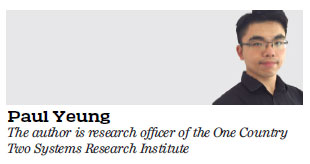HK should play key role in Southern Transport Corridor
Updated: 2018-11-29 07:33
(HK Edition)
|
|||||||||
Hong Kong, a key regional logistics hub and an international maritime center, is facing more and more challenges and competition from around the world. In "The Outline of the 13th Five-Year Plan for the National Economic and Social Development of the People's Republic of China" promulgated in 2016, the central government expressed support for Hong Kong in consolidating and enhancing its status as an international financial, transport and trade center, as well as promoting financing services, business and commerce, logistics and professional services toward high-end and high value-added development. Hong Kong should seize opportunities for national development and central government support to strengthen its international role.
It is vital to explore the latest trends and planning in the global market. One Country Two System Research Institute conducted research on the latest logistics development plan, namely the Southern Transport Corridor. My colleagues pointed out that the global trading system is changing. Traditionally, the system is characterized by the domination of maritime transportation, which is the traditional strength of Hong Kong as a free port. However, a new globalization pattern with strengthened land-sea interconnectivity has emerged due to the improvement of infrastructure connectivity. Meanwhile, inland regions have embraced the new wave of global industrial relocation and experienced rapid economic development. In particular, an electronic industry cluster has been established in western China over the last decade, driving international trade and opening up the region. Moreover, with its large population and economic improvements, domestic consumption is growing significantly.

The new trend mentioned above underlines the strategic location of western China, which connects the Belt and Road Initiative regions. Besides, the cargo traffic congestion over the Yangtze River has to be urgently addressed to accommodate rapidly growing trade from western China. China and Singapore proposed the Southern Transport Corridor under the framework of the China-Singapore (Chongqing) Demonstrative Initiative on Strategic Connectivity. The STC is designed to provide a shortcut for inland cargos to connect to the global shipping network through a railway-sea intermodal transport arrangement. The STC bureau headquarters are in Chongqing. Southbound loads will be transported by rail and arrive at the Qinzhou Port of Guangxi from where they will be shipped to Hong Kong or Singapore before reaching its overseas destinations, while northbound cargos will connect the China Railway Express at Chongqing and eventually reach Europe. As such, the STC links the Silk Road Economic Belt and 21st-Century Maritime Silk Road.
STC was officially renamed as International Land-Sea Trade Corridor in 2018. With the rapid development of the Chongqing-Guangxi-Singapore link, more and more western provinces, such as Sichuan and Yunnan, have joined in developing the STC. It has evolved into a multi-modal transportation network covering railways, highways and sea transports. STC has expanded into the so-called Pan-Southern Transport Corridor, which encompasses a broader market and a more significant impact.
Our research proposes the concept of Southern Economic Corridor, which covers Gansu, Sichuan, Chongqing, Guizhou, Yunnan, Guangxi, Guangdong, Hong Kong and Macao. To improve logistics efficiency, further consolidation of logistics resources in the southwest region is necessary. The idea of SEC aims to develop the area into a global manufacturing and trading hub that links with the Guangdong-Hong Kong-Macao Greater Bay Area and connects to European and Southeast Asian markets. By improving regional logistic efficiency, it will attract more resources at the core cities, thereby reaping the benefits of economies of scale. As a result, the logistics link could evolve into a trading channel.
ParagKhanna, a global strategist, in his new book Connectography, told us, "We're accelerating into a future shaped less by countries than by connectivity. Mankind has a new maxim - Connectivity is destiny - and the most connected powers, and people, will win." Strategically located at the heart of Asia, Hong Kong is connected to the world and the Chinese mainland by a world-class international airport, a container terminal renowned for its efficiency, and vast land crossings. Ranked by the Heritage Foundation as the world's freest economy for the 23rd consecutive year, our logistics industry is highly flexible in moving goods from one corner of the world to another. We have great advantages as a high-quality logistics center in the SEC. The key question is how to make full use of our advantages in this international connectivity project.
(HK Edition 11/29/2018 page8)